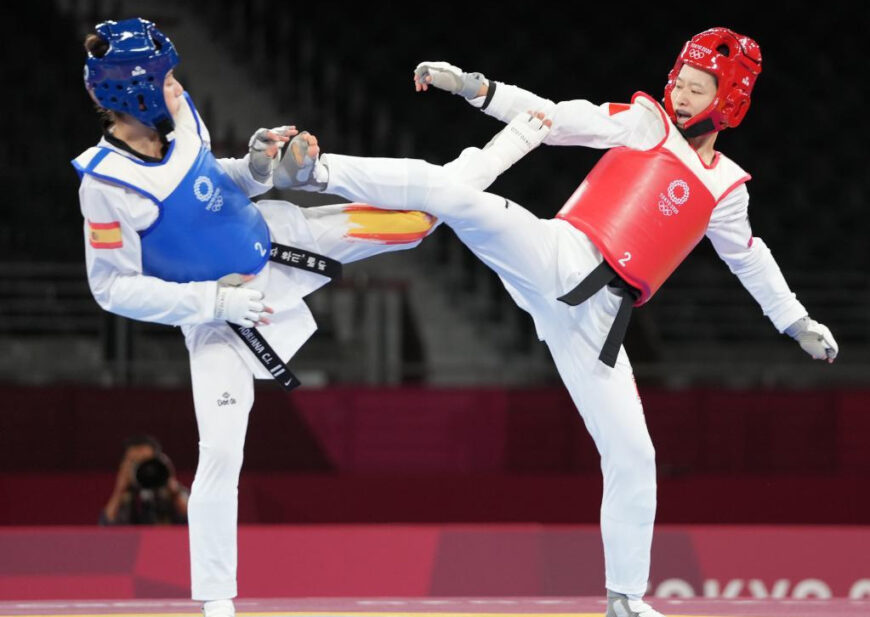Taekwondo, a dynamic martial art from Korea, is renowned for its explosive and diverse range of kicks. Offering both physical fitness and self-defense benefits, taekwondo kicks are essential to mastering this traditional martial art form.
With speed and power derived from large muscle groups, these impressive kicking techniques set Taekwondo apart from other combat sports such as karate or kung fu.
In this blog post, we’ll explore the unique world of Taekwondo kicking techniques – from basic kicks perfect for beginners to advanced moves.
Key Takeaways
- Taekwondo is renowned for its explosive and diverse range of kicks, making it unique from other martial arts.
- Mastering Taekwondo’s various kicking techniques offers many benefits, including improved physical fitness, flexibility, and leg strength.
- From basic front kicks to advanced double roundhouse kicks and flying back kicks – there are 15 different types of kicks in Taekwondo. Practicing these kicks can enhance one’s combat technique for self-defense situations or competitive sparring matches.
- Proper form and technique are essential when executing these powerful strikes. Although some kicking techniques may be more difficult than others, consistent practice and dedication can become an impressive part of any practitioner’s arsenal while offering potential showmanship during demonstrations or competitions.
Understanding Kicks In Taekwondo

The Significance of Kicks In Taekwondo
In Taekwondo, kicks hold a prominent position due to their speed, power, and effectiveness. The martial arts originated in Korea, emphasizing high and fast kicking techniques that utilize the body’s larger muscle groups more than other fighting styles.
The significance of kicks in Taekwondo is also deeply rooted in Korean culture and tradition. Historically, these powerful strikes symbolize the strength, confidence, and precision required to master this discipline.
Basic And Advanced Kicks In Taekwondo
In the world of martial arts, Taekwondo holds a special place due to its exceptional kicks. With a strong emphasis on speed, agility, and power, these distinct kicking techniques set it apart from other combat sports like Karate or Kung Fu.
There are 15 basic Taekwondo kicks that cater to all skill levels – ranging from fundamental techniques such as front kick (snap kick) and roundhouse kick, powered by larger muscle groups for maximum efficiency, to more advanced ones like downward roundhouse kick and double roundhouse kick which require greater control and agility.
As you progress through your journey with this dynamic martial art form built on Korean culture’s rich history, you’ll develop physical fitness while simultaneously enhancing striking techniques for self-defense situations or competitive sparring matches.
Uniqueness Of Taekwondo Kicks
Taekwondo kicks set themselves apart from other martial arts disciplines with unparalleled speed, power, and precision. Rooted in Korean culture and tradition, these dynamic striking techniques emphasize leg strength, agility, and flexibility to deliver devastating blows that can overwhelm opponents in both self-defense scenarios and competition sparring.
One notable aspect of Taekwondo kicking techniques is their airborne nature – many advanced kicks require athletes to jump or spin while executing the technique.
This adds a layer of complexity and challenges students to develop powerful strikes and impressive physical control, balance, and coordination.
Furthermore, Taekwondokas often target high areas such as the head during attacks, differentiating Taekwondo even more from other styles like kickboxing or karate, where low-level strikes are more prevalent.

Basic Taekwondo Kicks For Beginners
Learn the fundamental kicks in Taekwondo, including the front kick (Ap Chagi), sidekick (Yeop Chagi), and roundhouse kick (Dollyo Chagi).
1. The Front Kick – 앞 차기, Ap Chagi
One of the most frequently used kicks in Taekwondo is the front kick or “Ap Chagi.” This is also known as a snap kick since it involves snapping your leg straight out and returning it quickly.
The front kick’s main purpose is to create distance between you and an opponent, but it can also be used offensively to strike an opponent’s lower body.
To execute a proper Ap Chagi, stand with your feet shoulder-width apart, lift one knee towards the chest, and extend your foot out quickly while keeping your toes pointed towards the target.
Use the ball or heel of your foot to hit your target before returning to the starting position. It’s important to note that when executing this kick in self-defense situations, one should avoid kicking too high as this may cause a loss of balance and leave you vulnerable to counter-attacks from opponents.
https://www.youtube.com/watch?v=8gKvAQPWbKE
2. The Side Kick – 옆 차기, Yeop Chagi
The sidekick, or “Yeop Chagi,” is a fundamental taekwondo kick that involves striking the target with the foot heel. It’s often used to attack an opponent’s midsection or head from a semi-side-facing position.
To perform this kick correctly, you must first pivot on your support leg and then explode forward with your kicking leg while keeping it straight and rigid.
One advantage of using the sidekick is its versatility; it can be executed with either foot and from various angles, depending on where your opponent is positioned. Moreover, due to its long-range capability and power generation potential, this technique can effectively keep adversaries at bay or cause significant damage if landed properly.
3. The Reverse Side Kick – 반대 옆 차기, Bandae Yeop Chagi
The Reverse Sidekick, also known as Bandae Yeop Chagi, is a powerful, dynamic kick requiring precise technique and control. Unlike the sidekick from the front leg, this kick originates from the back leg and requires a quick body rotation before delivering a strong blow to the target with the heel.
This technique is often used in sparring competitions to surprise opponents by turning away from them and swiftly attacking when they least expect it.
One benefit of practicing this kick is that it helps improve balance and coordination while building strength in your core muscles.
4. The Roundhouse Kick – 돌려 차기, Dollyeo Chagi
The roundhouse kick, also known as “Dollyo Chagi,” is a basic taekwondo kick that involves pivoting on one foot while bringing the other leg around in a circular motion to strike the target with the foot’s instep.
To execute this kick correctly, it’s essential to maintain proper form by keeping your guard up, standing tall with your weight evenly distributed on both feet and pivoting smoothly on your support foot.
As you pivot on your support foot, lift your kicking leg so the knee points toward the target before swinging it around in an arc.
Mastering Dollyo Chagi takes practice and dedication, but incorporating this basic taekwondo kick into regular training routines will help improve striking ability and agility while building the strength and flexibility necessary for advanced techniques down the line.
5. Double Roundhouse Kick – Narae Chagi
The double roundhouse kick, also known as Narae Chagi in Taekwondo, is a more advanced kicking technique that takes significant practice to master.
This move involves kicking both legs simultaneously while pivoting on one foot and executing two roundhouse kicks quickly. This technique requires excellent coordination and balance to execute effectively.
Due to its difficulty level, the double roundhouse kick is often used for showmanship during demonstrations or competitions. Still, it can also be used as a powerful offensive move in self-defense situations.
6. The Back Kick – 뒷 차기, Dwit Chagi
The back kick, also known as dwi chagi in Taekwondo, is a powerful and effective technique used for self-defense situations. It involves turning your body away from the target and striking backward with the heel or bottom of your foot.
In addition to its practical applications in self-defense scenarios, the backkick can also be used in sparring competitions to surprise opponents who may not expect an attack from behind them.
7. Flying Sidekick – Twi Myo Yeop Chagi And Flying Back Kick – Twi Myo Dwi Chagi
The flying sidekick and flying back kick are two of the most exciting and dynamic kicks in Taekwondo. These kicks are executed by leaping into the air towards a target with one leg extended, then landing on the opposite foot.
The kicker can strike their opponent with a powerful blow from their heel or other striking surface.
In addition to being impressive to watch, these kicks have practical applications in self-defense situations and competitive sparring. They allow practitioners to close distances quickly and surprise opponents who may not expect such an acrobatic attack.
8. The Hook Kick – 후려 차기, Huryeo Chagi
The hook kick, or huryeo chagi in Korean, is a powerful and versatile taekwondo kick. It’s an advanced technique that requires balance, flexibility, timing, and coordination.
The hook kick involves swinging your leg around the target from the side and then striking it with your heel or sole. Many practitioners use the hook kick to attack their opponent’s head or neck while they’re guarding against punches or lower kicks.
One advantage of the hook kick is that it can surprise your opponent since it comes from an unexpected angle. Moreover, its circular trajectory makes it difficult for your opponent to block or counter unless they anticipate it perfectly.
To perform a successful hook kick in Taekwondo, you must pivot on your non-kicking foot as you raise your kicking leg and then whip it around like a “hook.” Your supporting hand should guard your face while your other hand extends outwards for balance.
9. Spinning Hook Kick – Dwi Huryeo Chagi
The spinning hook kick, also known as Dwi Huryeo Chagi in Taekwondo, is an advanced kicking technique that requires balance, flexibility, and precision.
This kick involves spinning the body around on one leg while simultaneously throwing out the other to deliver a horizontal kick at the target. The spinning motion generates momentum, adding power to the kick, making it extremely effective for offense and defense.
In competitive sparring or self-defense situations, Taekwondo practitioners use this powerful kicking technique effectively against their opponents. It is commonly seen in high-level competition, where fighters use it when they want to surprise or knock out their opponent with its fast rotation and sudden impact.
10. Inner Or Outer Crescent Kick – An Chagi Or Bakkat Chagi
Another kick commonly taught in Taekwondo is the inner or outer crescent kick, also known as An Chagi or Bakkat Chagi. This technique involves making a circular movement with your leg and foot, either inward (a chagi) or outward (bakkat chagi), to hit targets on either side of the body.
To execute this move effectively, it’s important to have good balance flexibility and a solid understanding of proper form. The inner/outer crescent kick can be particularly effective when combined with other kicks, strikes, and defensive techniques during sparring matches or self-defense situations.
11. Scissor Kick – Kawi Chagi
The scissor kick, also known as Kawi Chagi, is another advanced Taekwondo kicking technique that requires good coordination and balance.
To execute this move, the leg is raised high before being brought down with force towards the target.
This kick can be particularly effective against opponents who are off-balance or not expecting such a maneuver. It requires much practice and precision to perform well, but mastering this unique kicking technique can give practitioners an edge in combat situations.
12. Twist Kick – Bituro Chagi
The twist kick, or bituro chagi in Taekwondo, is a more advanced and tricky one to master. It involves twisting the hips while simultaneously extending the leg out to strike your opponent with the heel.
Depending on how you angle your supporting foot, the twisting kick can be executed as a front or roundhouse kick.
One interesting fact about the twisting kick is that it was popularized by taekwondo master Jhoon Rhee, also known for being Bruce Lee’s friend and sparring partner.
He developed his version of the twist kick called “Jhoon Rhee Kick,” which became his signature move in martial arts demonstrations and exhibitions.
https://www.youtube.com/watch?v=gmdh9Uy_sBA
13. Axe Kick – 내려 차기, Naeryeo Chagi
The axe kick, or Naeryeo Chagi in Taekwondo, is a powerful and dynamic kicking technique that is both effective and visually impressive. It involves lifting the leg high overhead before striking down with the heel of the foot to deliver a devastating blow to the opponent.
This kick is often used in self-defense as it can generate significant force and cause crippling damage to an attacker. Proper execution of this technique requires strength, balance, flexibility, and coordination.
14. Knee Strike – Mureup Chigi
The knee strike, also known as Mureup Chigi, is a powerful and versatile kick in Taekwondo. It involves striking an opponent with the knee, either from a standing position or while jumping forward.
The knee strike can be executed to various body parts, such as the groin, abdomen, chest, or head, with devastating effects.
One interesting fact about this technique is that it’s not only effective for offensive attacks but also for defensive purposes. If an opponent charges at you aggressively, you can use your front leg to block their attack by raising your knee before they make contact and using the same momentum to deliver a counter-knee strike.
15. Push Kick – 밀어차기, Mireo-Chagi
Another basic taekwondo kick for beginners is the push kick, also known as “meereo chagi.” This kick involves using the ball of your foot to push or thrust forward towards a target.
One important factor when executing a push kick is to keep your leg straight and locked out at the moment of impact. Another key component is utilizing proper weight distribution by leaning back slightly before extending your leg forward.
In addition to its practical applications in self-defense situations, incorporating push kicks into your training routine can also help improve cardiovascular health and increase overall lower body strength.
Proper Kicking Techniques In Taekwondo
Proper form is essential for executing effective kicks in Taekwondo.
Fundamentals Of Proper Form
To execute powerful and accurate kicks in Taekwondo, proper form is essential. The first fundamental aspect of form is maintaining balance throughout the kick.
The second important aspect of form is keeping both feet pointed forward, which ensures that energy flows from the ground up through your body and into your kick.
By twisting your hips and shoulders towards your opponent just before kicking, you can generate extra power for maximum impact.
Essential Drills For Developing Technique
To become a skilled taekwondo kicker, you must focus on drilling basic kicks until they become second nature. Here are some essential drills for developing technique:
- Shadow Kicking: Practicing kicks without a partner, focusing on proper form and technique.
- Target Practice: Using pads or targets to develop kick accuracy and power.
- Balance Training: Working on balance exercises like standing on one foot or using a wobbleboard to improve stability during kicks.
- Plyometric Training: Incorporating explosive movements like jumping and bounding into your training routine to increase strength and power.
- Resistance Training: Using weights or resistance bands to build leg strength and endurance necessary for powerful kicks.
- Interval Training: Incorporating high-intensity intervals into training sessions to build cardiovascular endurance while practicing various kicks.
- Partner Drills: Practicing with a partner, alternating between offensive and defensive strategies, developing timing, speed, and accuracy in executing different kicks.
Consistent practice is essential for mastering any martial arts technique, including Taekwondo kicking techniques. By regularly incorporating these essential drills into your training routine, you can develop the strength, speed, agility, and flexibility needed to perform effective Taekwondo kicks like a pro!
Tips For Improving Your Kicks
To improve your kicks in Taekwondo, practice is essential. Some tips to consider while practicing include:
- Focusing on proper form and technique.
- Utilizing essential drills for developing balance and strength.
- Incorporating stretching exercises to increase flexibility.
Additionally, it’s crucial to build strength in the larger muscle groups that power taekwondo kicks.
Another tip for improving your kicks is using targets during practice sessions.
Targets help with accuracy and enable you to develop more power when delivering a kick.
Lastly, avoid common mistakes like telegraphing your moves or failing to follow through entirely with the kicking motion.
https://www.youtube.com/watch?v=G_U77arlUX0
Executing Taekwondo Kicks With Accuracy And Power
Building strength and flexibility through conditioning exercises such as squats, lunges, and stretching is important to execute Taekwondo kicks with accuracy and power.
Using targets can also help improve the precision of your kicks while increasing their force.
Building Strength And Flexibility
Building strength and flexibility in the legs is essential to effectively execute taekwondo kicks with power and accuracy. Regular kicking techniques can help develop leg muscles, improving strength and endurance.
Strength training exercises such as squats, lunges, and calf raises can be incorporated into routine workouts to boost lower body strength. Flexibility drills such as hamstring, butterfly, and groin stretches are also crucial components in building a more flexible physique required by taekwondo kicks.
Using Targets For Accuracy And Power
Targets are an essential part of training in Taekwondo to improve accuracy and power when executing kicks. Targets can be stationary or moving and come in various shapes and sizes.
When using a target, practitioners should focus on hitting the center of the target with proper technique. This improves accuracy and enhances power by allowing the leg muscles to engage fully during impact.
Overall, incorporating target practice into taekwondo training is essential for anyone looking to improve their kicking ability.
Common Mistakes To Avoid
Making mistakes is a natural part of learning, but avoiding them can help you progress faster. When it comes to taekwondo kicks, here are some common errors you should try to steer clear of:
- Neglecting your foot positioning: Proper positioning is crucial when performing taekwondo kicks. Ensure your supporting leg is steady and your foot is pointing in the right direction.
- Failing to engage your core: Your core muscles play an important role in generating power for your kicks. Engage them by keeping your abs tight and your back straight.
- Lifting your heel too early: Lifting your heel before executing the kick can signal your move to your opponent and compromise the strength of the kick.
- Not extending enough: To maximize the efficacy of taekwondo kicks, you need to extend fully and make contact with full force.
- Holding back on speed and power: Taekwondo kicks are meant to be fast, explosive, and powerful. Don’t hold back when you perform them; strive for maximum speed and strength.
- Being too predictable: Avoid falling into patterns that your opponents can anticipate easily. Mix up different types of kicks, feints, and movements to avoid becoming predictable.
Practical Applications of Kicks In Taekwondo
Kicks In Self-Defense Situations
In self-defense situations, executing effective kicks can be a game-changer. Taekwondo’s emphasis on kicking techniques makes it an ideal martial art for self-defense.
Kicks such as the front, roundhouse, and sidekick can create distance between you and your attacker while also inflicting damage. In addition, Taekwondo teaches practitioners how to target vulnerable areas of the body with kicks, such as the groin or knee joint.
Effective Kicking Strategies In Competitive Sparring
- Control Distance – Maintaining proper distance from your opponent is key to executing effective kicks. Use footwork to control the distance and create openings for your kicks.
- Target Selection – Choose the right target for each kick based on the situation and your opponent’s weaknesses. Aim for areas like the midsection, head, or legs, depending on what will give you an advantage.
- Timing – Timing is crucial in sparring when executing kicks. Wait for the right moment to strike and take advantage of any openings your opponent may give you.
- Speed & Power – Taekwondo kicks require both speed and power to be effective in competitive sparring matches. Work on increasing leg strength and flexibility through training drills regularly.
- Combination Kicks – Mixing up different types of kicks can often surprise your opponents, making it harder for them to defend against them effectively.
- Follow-Through – Always follow through with your kicks, even if they miss or hit a non-vital target area. This ensures you don’t leave yourself open to counter-attacks from your opponent.
Benefits of Incorporating Kicks Into Your Taekwondo Practice
Increase Confidence And Self-Esteem
Incorporating kicks into your taekwondo practice can boost your confidence and self-esteem. As you master new kicking techniques, you’ll gain a sense of accomplishment.
Moreover, the emphasis on discipline and perseverance in taekwondo training further reinforces positive self-image and instills a sense of pride.
The discipline required to master these complex techniques allows for mental growth alongside physical development. Regular practice builds confidence by reinforcing the belief that persistence pays off with incremental improvements.
Studies have shown that martial arts help build physical strength and mental well-being by teaching stress management techniques.
Burn Calories And Improve Cardiovascular Health
Incorporating taekwondo kicks into your exercise routine can help burn calories and improve cardiovascular health. Taekwondo is a full-body workout that engages multiple muscle groups, especially the legs, essential for executing powerful kicks.
Perring various kicking techniques repetitively increases your heart rate and oxygen intake, improving your overall aerobic capacity. For example, the roundhouse kick alone targets several muscles in the lower body while requiring significant energy expenditure.
Provide A Self-Defense Advantage
One of the primary benefits of incorporating kicks into your taekwondo practice is the self-defense advantage it provides. Taekwondo is known for its powerful and explosive kicks, which can be used to effectively defend against attackers in real-life situations.
For instance, the sidekick effectively keeps distance between yourself and an attacker while delivering a strong blow at their midsection. Similarly, the roundhouse kick can strike multiple areas, such as the head or legs, depending on your target’s position.
Mastering Taekwondo kicks improves physical fitness and empowers individuals with practical self-defense skills for everyday life.
Develop Flexibility And Coordination
You can develop greater flexibility and coordination by incorporating kicks into your taekwondo practice. Because many of the kicks in Taekwondo require a wide range of motion, practicing them regularly can help improve your overall flexibility.
You’ll become more comfortable executing complex kick techniques as you train consistently. This enhances your ability to perform these movements and carries over into other areas of physical activity.
Enhance Balance And Agility
Incorporating kicks into your taekwondo practice can enhance your balance and agility. The combination of leg strength, coordination, and flexibility required to perform these moves helps you develop body control and stability.
For instance, the sidekick demands you raise one leg off the ground while pivoting on the supporting foot. It challenges your sense of equilibrium and trains you to transfer weight efficiently between limbs.
Learn More About Taekwondo
- Taekwondo Weapons To Try
- Basic Taekwondo Forms To Master: Unlock Your Inner Warrior
- Taekwondo Vs Karate: The Ultimate Showdown
- Top 10 Greatest Taekwondo Players of All Time
- Best Martial Arts for Streetfight: Unleash Your Inner Warrior
- Best Taekwondo Schools in the World
- Top 21 Deadliest Martial Arts in the World According to Experts
- Taekwondo Belt Levels and Ranking Guide
- Taekwondo Stances
FAQs
1. What are the different types of kicks in Taekwondo?
There are several types of kicks in Taekwondo, including front kick, roundhouse kick, sidekick, axe kick, back kick, and spinning hook kick. Each type has its technique and purpose in combat.
2. How can I improve my kicking abilities in Taekwondo?
To improve your kicking abilities, it is important to practice regularly with a focus on proper form, balance, and speed. Additionally, strengthening exercises specifically targeted toward leg muscles, like squats or lunges, can help increase the power behind each strike.
3. Is it necessary to use all the different types of kicks in Taekwondo sparring?
It is unnecessary to use every type of kick during sparring matches. Each participant will have their preferred techniques depending upon their fighting style and experience level. However, knowing a wide range of moves gives an advantage over competitors who may stick to only one or two options.
4. Can anyone learn to perform advanced kicks like the spinning hook or flying sidekick?
Most students should be able to learn these advanced techniques with patience & dedication by starting with basic movements & gradually progressing through difficulty levels over time – taking into account individual fitness levels & limitations that could impact ability/comfortability when performing aerial maneuvers.
Conclusion:
The importance of Kicks in Taekwondo and beyond.
In conclusion, kicks are an essential aspect of Taekwondo, known for its explosive power and speed. From basic front kicks to advanced roundhouse and crescent kicks, the discipline offers 15 different types of kicks.
Proper form and technique are crucial in executing these kicks with accuracy and power while avoiding common mistakes. Incorporating these techniques into a regular exercise routine improves physical fitness and provides self-defense strategies in real-life situations.









